F19 calendar




23 August 1939
The Molotov-Ribbentrop pact was signed on 23 October. It divided Europe in separate areas of interest and Finland was placed in the Soviet area of interest.
1 September 1939
On 1 September, Germany invaded Poland.
3 September 1939
Great Britain and France declare war on Germany on 3 September. The Second World War begins.
22 September 1939 – 1 October 1939
Between 22 September and 1 October, the Foreign Ministers of the Baltic States were called to Moscow for discussions.
12 October 1939 – 9 November 1939
Finnish delegation negotiated in Moscow between 12 October and 9 November.
11 October 1939
As a result, from negotiations with Moscow the military preparedness was reinforced in Finland on 11 October.
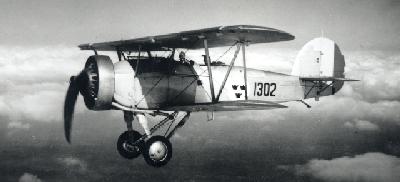
30 November 1939
The Winter War begins on 30 November when four Soviet armies crossed the frontier to Finland without a declaration of war.
6 December 1939
Finlandskommittén (The Finland committee) was founded in Stockholm during the day.
8 December 1939
Flygstaben (The staff of the Royal Swedish Air Force) began the organisation of a voluntary air unit.
14 December 1939 – 15 December 1939
The Swedish Government permitted a voluntary air unit.
13 December 1939 – 17 December 1939
Between 13 and 17 December Kapten (Captain) Bjuggren met with Finnish Headquarter for an operational basis of a voluntary Swedish air unit.
20 December 1939 – 30 December 1939
Recruitment of personnel, acquisition of material, organisation and reconnaissance of an airbase in Northern Finland were made between 20 – 30 December.
Twelve Gloster Gladiators (marked as yellow “A” to “L” and four Hawker Harts (marked as “R” (later re-marked as “N”), “X”, “Y” and “Z”) were allocated to the unit, which had been named as F19 (F19=flygflottilj no. 19 – roughly translated to wing no. 19).
28 December 1939 – 31 December 1939
The staff and ground personnel were transported to Veitsiluoto on railroad between 28 – 31 December.
1 January 1940 – 10 January 1940
The aircraft were flown to Veitsiluoto between 1 and 10 January.
11 January 1940
F19 received a Junkers F-13 transport aircraft (b/n 2069) during the day.
The previous owner of this aircraft was the flight-company ABA where it had been coded SE-ACK and named "Gästrikland". The code in Finland was at first OH-SUO. This aircraft was the sole of F 19's aircraft subsequently left behind in Finland. The new serial became JU-120 and it survived the Continuation- and Lappland War; the last flight was 6 February 1947.
1 January 1940 – 11 January 1940
Between 1 and 11 January the rear base was finished. At the same time was the forward base ”Oskar” established at Olkkajärvi, 15km north-east of Rovaniemi.
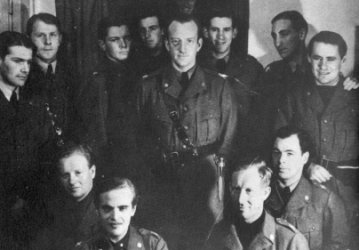
12 January 1940
Baptism of fire.
At 13:10, four Hawker Harts and four Gloster Gladiators led by the CO of F 19, major Hugo Beckhammar in the backseat of the Hart flown by fänrik (Pilot Officer) Åke Mörne took off from airbase ’Oskar’ (Olkkajärvi). The mission was air reconnaissance and ground-attack against airbase and troop concentrations at Märkäjärvi, Salmijärvi, Salla. They first bombed a column at Salmijärvi and then attacked the airbase at Märkäjärvi where 145 IAP was based. Three I-15s were reportedly destroyed on the ground; one each credited to löjtnant (Lieutenant) Per Sterner, fänrik Mörne and fänrik Martin Wennerström.
Three I-15bis from 145 IAP led by Leitenant Kruchkov with Leitenant Gromov and Leitenant Bondarenko as wingmen managed to intercept the raid and shot down Hart ‘Z’ six kilometres south of Salla.
Fänrik Ian Iacobi intercepted Soviet I-15bis and claimed one of them shot down. However, this claim is not confirmed by 145 IAP documents.
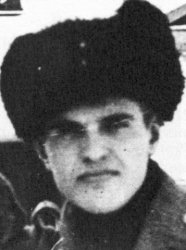
Wennerström reported:
‘When we approached the lake Märkäjärvi, I dropped my 12 kg bombs on Soviet aircraft on the ice. First you dive to a low altitude and then you drop the bombs at the last moment. After this you take up and continue at ground level and escape among hills and valleys. This scattered our fighter flight and this wasn’t particularly clever. But none of us had any previous combat experience. I climbed in a north-east direction and was the only escort for three of the Harts. Suddenly I saw two of them floating down towards the ground. Parachutes opened. I saw a black explosion where one of the aircraft hit the ground. I thought that the Russians was damned good sharp shooters and kept an extra sharp look out on the ground and for anti-aircraft explosions. But what I actually had witnessed was the collision of two of the Harts.”’During the attack F19 lost three Hawker Harts (“X”, “Y” and “Z”). Two was lost in a collision with each other as reported by Wennerström. In the first Hart, the pilot löjtnant Sterner became a Soviet POW and the observer löjtnant Anders Zachau was killed. The second Hart’s pilot fänrik Arne Jung also became a Soviet POW but his observer sergeant (Flight Sergeant) Matti Sundsten managed to ski back to the Finnish lines. Fänrik Gunnar Färnström and sergeant Thure Hansson made a forced landing after being shot down in the third Hart (‘Z’) but both managed to ski back to the Finnish lines.
Both Sterner and Jung was captured by Soviet troops after parachuting and became POW’s. They were tortured and beaten for four months before they were repatriated back to Sweden in May 1940.
15 January 1940
Area defence of Uleåborg were established at forward base ”Ulrik”.
Armed reconnaissance flown against Salla by F19.
17 January 1940
Forward base established at Hirvasjärvi (”Nora”).
Armed reconnaissance flown against Märkäjärvi-Salla by four Gladiators. While undertaking the reconnaissance, four I-15s were spotted at around 12:00. Fänriks (Pilot Officers) Roland Martin and Per-Johan Salwén opened fire at a distance of 400 meters. The Soviet aircraft dived and disappeared. The next day the Finnish radio-surveillance reported that a report from the Soviet fighter base at Kairala had been picked up. The report stated that at 12:10 on 17 January, four Finnish unknown aircraft had been spotted above Märkäjärvi on an easterly course. Lieutenant Benediktov forced landed at Märkäjärvi. The forward part of the aircraft was crushed and the pilot was wounded. Lieutenant Bondarenko made an emergency landing 14 km west of Kuolajärvi. The aircraft was destroyed but the pilot was unharmed. Russian sources claims that the aircraft shot down by Salwén was a I-15bis from 2./145 IAP flown by Lieutenant Bondarenko who was killed. The aircraft shot down by Martin (Lieutenant Benediktov) is not mentioned in Russian sources.

19 January 1940
Forward base ”Svea” was established north of Posio.
20 January 1940
Armed reconnaissance flown against Märkäjärvi-Salla and south-east against Kuusamo by F19.
21 January 1940
During the day Soviet bombers attacked Uleåborg heavily. Demands on fighter defence were increased after this.
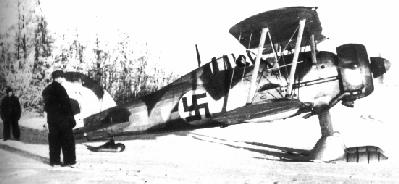
22 January 1940 – 23 January 1940
Kairala was attacked by F19 during the night.
23 January 1940
Between 12:05 and 13:25, four Gladiators under command of fänrik (Pilot Officer) Ian Iacobi flew a fighter-sweep over Märkäjarvi-Salmijärvi. The mission was to protect ground-forces in the area against enemy aircraft. The Finnish front and supply troops had been under a hard and constant pressure by Soviet rotes and flights, which attacked every twenty minutes.
During the first hour of the sweep, there were no enemy contacts. Around 13:10 a group of I-15bis’ of 145 IAP under the command of Leytenant Konkin was sighted on a westerly course and a dogfight begun. The Soviet pilots’ reported one “enemy reconnaissance” biplane shot down by Leytenant Konkin at Mjattijärvi. The aircraft started to burn and crashed 3-4 km south of Mjattijärvi. The pilot was killed. Three Soviet aircraft were also hit. One of them returned with 14 bullet-holes, another with one and the third with 25 bullet-holes. The Swedish pilot fänrik John Sjöqvist (born 14 March 1918) was killed when his Gladiator “B” crashed burning, west of Märkäjärvi, inside enemy lines.
After this dogfight, three Soviet I-16s were sighted at high altitude and since the Swedish pilots now started to get low on ammunition and fuel they retreated back to base at minimal altitude.
26 January 1940
Armed reconnaissance flown against Alakurtti (50km east of Salla)-Tolvantojärvi-Vuorijärvi by F19.
Forward base ”Nora” at Hirvasjärvi was attacked and bombed by Soviet aircraft during the day but the base wasn’t damaged.
28 January 1940 – 2 February 1940
Between 28 January and 2 February kapten Bjuggren travelled to Stockholm to investigate the possibilities to reinforce the unit.
28 January 1940
Armed reconnaissance flown against Kiimasvaara (55km east-south-east Kuusamo)-Korpijärvi-Suuri Pyylinen-Hamevaara by F19.
29 January 1940 – 30 January 1940
Personnel and material reinforcements were sent to the forward bases between the 29 and 30 January.
30 January 1940
The forward base ”Nora” at Hirvasjärvi was moved and re-established south-east of Kemijärvi (”Nora 2”).
31 January 1940
Armed reconnaissance flown against Märkäjärvi-Salla-Saija by F19.
It is decided that Rovaniemi also is to be defended by fighters.
1 February 1940
On the morning a three-plane group of Gladiators flew a combat air-patrol on 3000 meters over Rovaniemi. At 10:30 eight DB-3s and twenty-six SBs from 5 OSAP attacked Rovaniemi. They together dropped 23000 kg of bombs. The first group escaped but from the second group, a SB-bomber (s/n 15/59) from 3./5 OSAP was shot down by fänrik (Pilot Officer) Per-Johan Salwén 78km north of Rovaniemi. The crew of the SB with pilot, Lieutenant Boris M. Babkin, observer, Lieutenant A. U. Melnik and air-gunner, non-commissioned officer B. I. Batorin were killed. The wreck of the Soviet counted over two hundred machine-gun hits.
During the combat Soviet air-gunners reported that they shot down two enemy-fighters of eleven attacking, but F19’s three Gladiators didn’t sustain any losses.
This victory was the first bomber shot down by F19.
2 February 1940
The unit received a Waco transport aircraft.
The previous owner of this aircraft (SE-AHM) was AB Björkvallsflyg. In Finland the temporary serial was OH-SLA. Only the serials were painted on both sides of fuselage with no national insignia (a Finnish flag was painted on the tail).
4 February 1940 – 5 February 1940
Salla was attacked by F19 during the night.
9 February 1940
The unit received a Raab-Katzenstein RK-26 Tigerschwalbe liaison aircraft.
This aircraft was former SE-ADK. In Finland the national insignia were painted but no serials. The use of the aircraft was quite limited due to poor general conditions and due to lack of needed spare-parts.
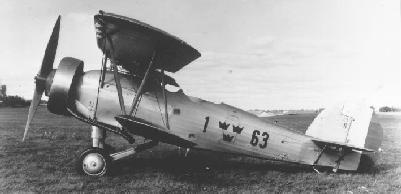
16 February 1940
The unit received reinforcement in form of a Hawker Hart light bomber (coded ”M” to replace previously losses.
18 February 1940 – 19 February 1940
Kairala and Salla were attacked by F19 during the night. One I-15 was destroyed on the ground at Kairala by fänrik (Pilot Officer) Åke Mörne of the F19 Attack Squadron.
18 February 1940 – 22 February 1940
Between 18 and 22 February the SFK (the Swedish Voluntary Corps) was loaded on train at Kemi and transported to Kemijärvi. F19 provided fighter protection of the transport.
19 February 1940 – 20 February 1940
Märkäjärvi was attacked by F19 during the night.
20 February 1940
F19 got an early morning alarm when a flight of SBs from 3./16 SBAP was reported on its way westward from Uhtua. A rote Gladiators with fänrik (Pilot Officer) Per-Johan Salwén and fänrik Gideon Karlsson scrambled at 08:40 from forward base ”Ulrik” at Uleåborg. They managed to intercept the attacking bombers 30 minutes later at Vaala at 2500 meters. Salwén hit two of the SBs before he run out of ammunition. The observer in the first SB Lieutenant A. Ja. Avrutskij misunderstood the instructions from the pilot and parachuted to become a POW. The aircraft managed to struggle back to base to do a wheels-up landing. Salwén’s fire and/or the wheels-up landing wounded the pilot Lieutenant Mihail A. Borshev and gunner Nikolaj A. Troshenko. The aircraft was a write off. The second SB was damaged and the tailgunner Aleksandr P. Popov was mortally wounded and died a week later on 27 February 1940. Gideon Karlsson also hit this second SB.
Salwén’s Gladiator was damaged with a bullet-hole in the wing from enemy return fire and a hole trough the propeller due a failing synchronisation.
Gladiator “E” got caught in a storm and crashed at Uleåborg during emergency landing and was a totally write-off. The pilot of this aircraft is unknown.
21 February 1940
Twenty-six SBs and thirteen DB-3s from 5 OSAP attacked Rovaniemi around 12:00. They together dropped 14600 kg of bombs. The returning bombers reported that enemy fighters shot down one SB and one DB-3, while air-gunners claimed two enemy fighters destroyed.
The enemy fighters were a four-plane group from F19, which was in the air. Two of the Gladiators had to return due to fuel shortage before any contact with the enemy formation. The two remaining Gladiators flown by fänriks (Pilot Officers) Arne Frykholm and Carl-Olof Steninger attacked the Soviet bombers and they shared the destruction of one DB-3 and one SB-2 south-east of Rovaniemi.
The DB-3 (“11”, s/n 391695), which landed pretty much intact 18 km north-west of Vuotso, had dropped its bombs over Pajala on the Swedish side of the border! The pilot Lieutenant Aleksej N. Isatshev was captured, but the observer, Lieutenant F. Zaprjagajlev and air-gunner, Sergeant Major V. F. Volkov were killed.
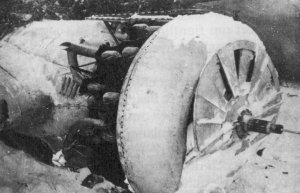
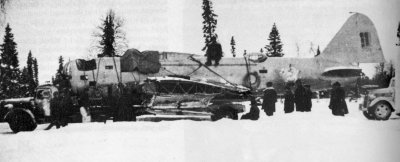
The damaged SB (s/n 5/95) from 3. Group was last seen leaving, trailing black smoke and didn’t return. The crew with pilot, Lieutenant Ivan D. Danilenko, observer, Lieutenant Aleksej A. Losev and air-gunner, Sergeant Major A. P. Petrov were reported missing in action.
Soviet air-gunner claimed two enemy fighters shot down but F19 didn’t sustain any losses during this combat.
22 February 1940 – 23 February 1940
Märkäjärvi was attacked by F19 during the night.
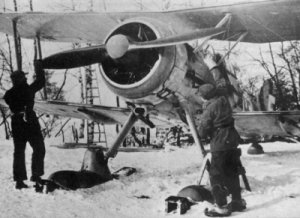
26 February 1940
Fänrik (Pilot Officer) Ian Iacobi takes over command of the Fighter Squadron from kapten (Captain) Åke Söderberg, who leaves for Sweden.
1 March 1940
The area defence of Rovaniemi and Uleåborg was moved forward to forward base ”Svea” at Posio with one Gladiator.
2 March 1940
The area defence of Uleåborg was moved forward to forward base ”Ulrik 2” at Vaala with one Gladiator.
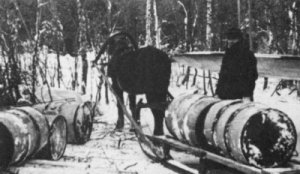
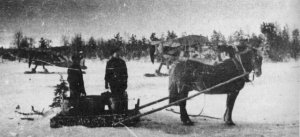
7 March 1940
Two SBs from 34 DRAE (long-range reconnaissance) of AG Spirin were shot down 65km southeast of Uleåborg. The aircraft were shot down at Vaala by fänrik (Pilot Officer) Einar Tehler of F19 and crashed at Utajärvi.

Both crews (Lieutenant Aleksejev, Sub Lieutenant Morozov and Sub Lieutenant Segkin in one aircraft and Captain Grebennikov, Lieutenant Matsnev and Sergeant Major Lepika in the second) were killed.
Tehler who had been scrambled from Vaala reported that the combat took place above clouds against three SB-2s at 14:00-14:10. The right SB was hit first. White smoke evaporated at first, which changed over to black smoke. The aircraft began to lag behind its formation and stated to descend against the ground. He then attacked the left aircraft. His hits were good. During the combat, his Gladiator was hit in one of his fuel tanks and he had to return to Vaala. The return flight was dramatic and he was drenched in gasoline. He did a half-roll and prepared to force-land after he had turned of the fuel tap. When he passed below 400 meters, he re-opened the fuel tap and restarted the engine since he hadn’t found any good place to force-land on. He was able to fly his damaged fighter to forward base ”Ulrik” at Uleåborg. On the ground, the aircraft was examined and it was found that the bullet had penetrated the fuel tank and carried on into the compass in the cockpit.
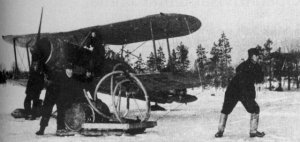
8 March 1940
Per-Johan Salwén damaged one SB-2 east of Vaala during the day.
10 March 1940
The TB-3 squadron (ex 1 TAP) of Air Group Spirin attacked Rovaniemi and one aircraft didn’t return. This TB-3, flown by Sub Lieutenant Sergej T. Karepov was shot down by fänrik (Pilot Officer) Gideon Karlsson of F19, 5km east of Kemijärvi at 14.30.
The aircraft (s/n 22198) force-landed on the ice on Lake Murtoselkä. Five crewmembers were killed among them the pilot, the observer Lieutenant Nikolaj Vorobtshikov, the second pilot Senior Lieutenant Boris M. Kogan and Senior Lieutenant Kirill Shestihin. Three air-gunners were captured. These were Sergeant Majors Nikolaj Grigorjevitj Globa (24 years old), Aleksej A. Zatonov and Grigorij V. Zaharov.
Karlsson who was on a combat air patrol found surprisingly six TB-3s at 2000 meters over Rovaniemi and attacked them. The enemy aircraft turned around without dropping their bombs when he attacked. He concentrated on one of them and managed to damage it. It started to lag behind, dropped its bombs and descended, trying to find a place to force-land with all four engines damaged. Karlsson was forced to return to base after having been hit in the propeller. He had also almost exhausted his ammunition and returned to the rear base.
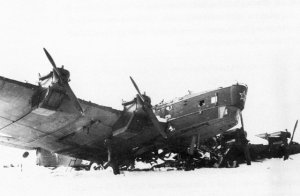
The enemy aircraft force-landed 5km east of the south end of Lake Kemijärvi. All of the crewmembers survived the crash but when they tried to put on resistance against Finnish ground troops, five of them were killed.
Forward base ”Svea” at Posio attacked by Soviet aircraft. The attack doesn’t do any damage to the base.
At 14:10 ingenjörlöjtnant (Engineer Lieutenant) Åke Hildinger took off from Veitsiluoto for a test flight in Gladiator “D” (no. 274). Hildinger was F19’s flottilingenjör (Wing Engineer) and the Gladiator he was testing had had an engine change. Something went wrong during the test and the aircraft was seen doing a long dive and when the pilot pulled up, an explosion was heard and the aircraft crashed into the ice-covered lake. When the rescue team reached the destroyed aircraft, Hildinger was found dead in the cockpit. The subsequent investigation showed that the aircraft has been torn apart in a steep dive at an altitude of 1000 meters. During the dive, the skies of the aircraft had been twisted down and backward. This meant difficulties in pulling up from the dive and that only the elevator hadn’t been enough and the use of trim tabs had been necessary. Continuos dive with twisted skies meant difficulties and ended in destruction of wings and fuselage. The investigation ended in a statement that the present ski design was not satisfying. The autopsy showed that Hildinger was struck by an aircraft part and unconscious when the aircraft hit the ground. He was killed instantly on the impact.
11 March 1940
Armed reconnaissance flown against Märkäjärvi-Salla-Saija by F19.
11 March 1940 – 12 March 1940
Attack against car colon north-east of Märkäjärvi during the night by F19.
13 March 1940
At 11:00 the Winter War ends with a cease-fire.
Military preparedness was maintained for the local area defence until dusk.
13 March 1940 – 28 March 1940
Between 13 and 28 March the forward bases were wound up, material was taken care of and the transport back to Sweden was prepared. Air photography of the operational area of F19 started. Transport flight to the Swedish Air Force headquarters and Stockholm.
26 March 1940
Field Marshal Mannerheim thanked the SFK at Paikanselkä and at Kemi on 26 March.
29 March 1940 – 30 March 1940
Seven Gladiators, two Hawker Harts and the Raab-Katzenstein liaison aircraft returned to Sweden by air between 29 and 30 March.
The Raab-Katzenstein was destroyed in a crash on 23 June 1940.

30 March 1940 – 9 April 1940
The Veitsiluoto base was wound up between 30 March and 9 April.
The final report from F19 was compiled and sent to SFK.
8 April 1940 – 9 April 1940
The Waco returned to Hägernäs, Sweden, between 8 and 9 April 1940.
This aircraft later served in the Swedish Air Force as a Tp8 (a/c number 914).
9 April 1940
On 9 April German troops attacked Norway and Denmark. Big alarm and the military preparedness are strengthened in Sweden.
Next phase of the Second World War begins.
Sources:
F19 - en krönika - Greger Falk, Svensk flyghistorisk Förening, Stockholm, ISSN 0345-3413
F19 enligt ryska källor - Carl-Fredrik Guest, Ikaros - 1997 Flygvapenmusei Årsbok 1997, Linköping, ISSN 1102-1926
Hurricane & Gladiator: Suomen Ilmavoimien Historia 25 - Kalevi Keskinen and Kari Stenman, 2005, ISBN 952-99432-0-2
Ilmavoitot, osa 2 - Kalevi Keskinen and Kari Stenman, 2006, ISBN 952-99432-8-8
Kuulumiset magazine no. 4 - edited by Nils Treichel
Red Stars 7 - Talvisota Ilmassa - The Winter War In the Air - Carl-Fredrik Geust, 2011 Apali Oy, Tampere, ISBN 978-952-5877-04-5
Svenska flygare i österled - Björn Bjuggren, 1942 Åhlen & Åkerlunds Boktryckeri, Stockholm
Additional information kindly provided by Alex Crawford, Pertti Lehto and Andrew Thomas.

